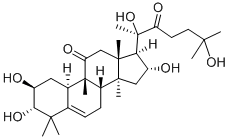Description
Cucurbitacin IIa and cucurbitacin IIb are the characteristic chemical constituents of
the hemsleya. Hemsleyadinum are extracted from the Cucurbitaceae,
Chrysanthemum, and Hemsleya, which have the function of clearing heat and
removing toxicity and antisepsis and anti-inflammation. There are 31 species of
Hemsleya in the world, most of which are distributed in China’s Yunnan, Guizhou,
and Sichuan provinces, besides the 2 species distributed in India and Vietnam. The
main species are H. emiensis, H. pengxianensis, H. amabilis, H. dolichocarpa, H.
graciliflora, and H. gigantha . Hemsleya plants are commonly used as Chinese
herbal medicines.
Physical properties
Appearance: rhombohedral or flaky crystals, Solubility: soluble in methanol, ethanol, and acetone, slightly soluble in chloroform, insoluble in water.
History
Hemsleyadinum and hemsloside inhibit Shigella dysenteriae, Salmonella
typhimurium, and Salmonella choleraesuis in?vitro. Intravenous injection of cucurbitacin IIa has mild antipyretic effect caused by intraperitoneal injection of typhoid
and paratyphoid bacteria but invalid to those with normal body temperature and
nonbacterial fever. Xuedansu tablets have significant antitussive effect and show
inhibitory effect against p-xylene-induced mouse ear swelling and carrageenaninduced rat toe swelling. Cucurbitacin IIa and cucurbitacin IIb also have anti-HIV-1
activity, which plays a vital role in HIV-1 virus infection . Hemsleyadinum has
significant protective effect against acute liver injury caused by CCl4, especially at
the high dosage .
Indications
Its dosage forms and indications are available at the Pharmacopoeia of the People’s
Republic of China (1977).
The current clinical use of hemsleyadinum includes tablets and capsules, which
are suitable for bacillary dysentery, enteritis, bronchitis, and acute tonsillitis.
Pharmacology
The main active ingredient in Cucurbitaceae plants is cucurbitacins, and cucurbitacin IIa and IIb have been used in clinics. Their indications include bacillary dysentery, enteritis, bronchitis, acute tonsillitis, and so on. Cucurbitacin IIa also has
anticancer effect . Cucurbitacin IIa (25–100?μM) dose-dependently inhibits proliferation of human lung adenocarcinoma A549 and mouse adenocarcinoma. It
blocks the G0/G1 and S phase of A549 cells and thus promotes cell apoptosis .
The anticancer mechanism of cucurbitacin IIa is to prevent cancer cell spreading by
destroying cytoskeleton of actin and leading to PARP-induced apoptosis by inhibiting production of downstream surviving of JAK/STAT3.
Clinical Use
At present, hemsleyadinum mainly are used as antibacterial and anti-inflammatory
drugs, suitable for treatment of upper respiratory tract infection, acute tonsillitis,
mumps, pharyngitis, acute and chronic bronchitis, pneumonia etc. Generally speaking,
hemsleyadinum and its preparations have less side effects, such as diarrhea, abdominal pain, and other gastrointestinal reactions.

